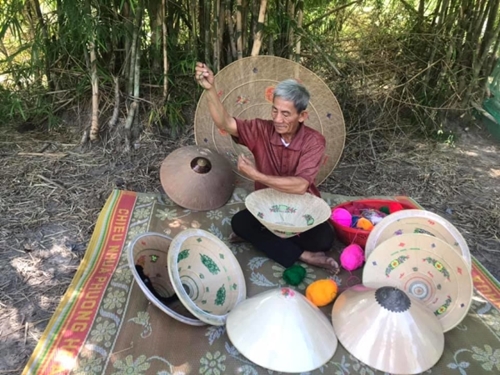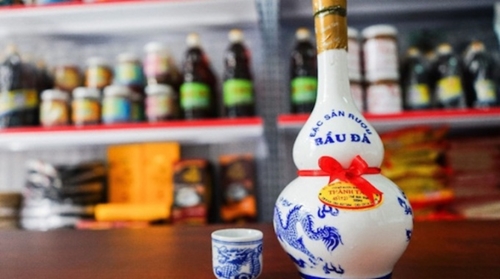Binh Dinh province is not only famous for its beautiful beaches and Champa culture, but also for many long-standing traditional craft villages. In recent years, visiting villages is a tourism product attracting many young people. This summer, when coming to Binh Dinh, tourists can explore the local culture and people by visiting the following famous craft villages.
Phu Gia conical hat village
Phu Gia conical hat village is located in Phu Gia village, Cat Tuong commune, Phu Cat district, about 45km North of Quy Nhon city center. The village has been making conical hats for more than 300 years. For local people, the hat is the symbol of resilience and stance of Tay Son region. In the past, it was made for those who rode the horse; therefore, it has been called “non ngua” (horse conical hat).
    |
 |
|
An artisan and conical hats around (Photo: Quy Nhon Hotel) |
To make a hat, the artisan must carry out three steps. After the hat is formed, it will be embroidered with motifs of peacocks, dragons, phoenixes, pheasants, flowers and leaves. The top of the hat is decorated with a bunch of five-colored threads.
Visitors to the craft village can have a chance to make the hat, enjoy the peaceful atmosphere of a South-central countryside village. After visiting the village, tourists can try Binh Dinh’s specialty dishes, such as banh xeo (a kind of pancake), spring rolls.
The price of each hat is about VND 50,000 to 100,000. Tourists can buy them to protect themselves from the sun or as gifts after the trip.
Nhon Hau wood turning handicraft village
Woodturning is a traditional craft of Nhan Thap village, Nhon Hau commune, Binh Dinh province, about 30km Northwest of Quy Nhon city center. Visitors can depart from Quy Nhon city to Nhon Hau by motorbike or car. It takes about 45 minutes.
Tourists can choose decorative products and household necessities from small to large such as tables and chairs, trays, tea sets...
These products help local households earn stable income. The price of handicrafts here is about a few hundred thousand to several million VND.
Van Son pottery village
If tourists want to enjoy a tranquil atmosphere and traditional quintessence, they can visit Van Son pottery village. It is located in Nhan Thap hamlet, Nhon Hau commune, An Nhon town, Binh Dinh province. Van Son pottery profession inherits the tradition of pottery production of the Cham people. The village specializes in the production of terracotta ceramics with a wide range of products for daily life, such as jars, pots, kettles, to name but a few.
    |
 |
|
Van Son pottery products (Photo: lendang.vn) |
While touring the village, travelers have a chance to witness local artisans making every stage to turn raw materials into wonderful ceramic products. The Van Son pottery village is famous for simple household utensils.
Bau Da wine village
Bau Da wine is one of the famous specialties of Binh Dinh province, originating from Bau Da hamlet, Cu Lam village, Nhon Loc commune, An Nhon district (about 30km from Quy Nhon city, Binh Dinh province). Bau Da wine is distilled from rice by families in the region as a family heirloom.
    |
 |
|
Bau Da wine is among top 10 Vietnam's specialties. (Photo: Binh Dinh Invest) |
As the legend goes, there is a water basin in the region, flowing from the surrounding mountains, creating the aroma and indescribable taste of Bau Da wine. Not only that, the fame of Bau Da wine is also in the very manual distilling method. According to elderly people with long experience in Bau Da wine making, to have a delicious pot of wine, material should be distilled for exactly 6 hours.
Hoai Chau Bac sedge mat weaving village
The sedge mat weaving village in Hoai Chau Bac ward, Hoai Nhon town, Binh Dinh province was established a long time ago, where hundreds of households are attached to the profession of growing and making sedge mats.
    |
 |
|
The artisan checks the quality of materials before weaving sedge mats. (Photo: Viettiles) |
There are two types of sedge mats in Hoai Nhon: smooth mats and flower mats. Plain mats are woven from rustic, idyllic white sedges. The flower mat is woven from white sedge fibers interspersed with dyed sedge fibers to create a unique patterned mat.
Source: VnExpress
Translated by Minh Anh